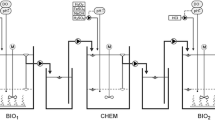Abstract
The Fered-Fenton process has been shown to be an effective method for leachate treatment, but it still faces problems of inadequate regeneration of ferrous ion. However, the use of the photoassisted Fered-Fenton process could overcome this difficulty and improve the efficiency of chemical oxygen demand (COD) removal since photoassisted Fered-Fenton process induces the production of hydroxyl radicals from the regeneration of ferrous ions and the reaction of hydrogen peroxide with UV light. As there are so many operating parameters in photoassisted Fered-Fenton process, it is necessary to develop a mathematical model in order to produce the most economical process. In the present study, a factorial design was carried out to evaluate leachate treatment by photoassisted Fered-Fenton process. The influence of the following variables: H2O2 concentration, Fe2+ concentration, current density, and initial pH in the photoassisted Fered-Fenton process was investigated by measuring COD removal efficiencies after 60-min reaction. The relationship between COD removal and the most significant independent variables was established by means of an experimental design. The H2O2 concentration, Fe2+ concentration, initial pH, and the interaction effect between current density and initial pH were all significant factors. The factorial design models were derived based on the COD removal efficiency results and the models fit the data well.








Similar content being viewed by others
References
Altin A (2008) An alternative type of photoelectro-Fenton process for the treatment of landfill leachate. Sep Purif Technol 61:391–397. doi:10.1016/j.seppur.2007.12.004
Ammar S, Asma M, Oturan N (2012) Electrochemical degradation of anthraquinone dye alizarin red: role of the electrode material. Curr Org Chem 16:1978–1985. doi:10.2174/138527212803251613
Anglada A, Urtiaga A, Ortiz I, Mantzavinos D, Diamadopoulos E (2011a) Boron-doped diamond anodic treatment of landfill leachate: evaluation of operating variables and formation of oxidation by-products. Water Res 45:828–838. doi:10.1016/j.watres.2010.09.017
Anglada A, Urtiaga A, Ortiz I, Mantzavinos D, Diamadopoulos E (2011b) Treatment of municipal landfill leachate by catalytic wet air oxidation: assessment of the role of operating parameters by factorial design. Waste Manag 31:1833–1840. doi:10.1016/j.wasman.2011.03.023
APHA, AWWA, WPCF (1998) Standard methods for the examination of water and wastewater, 20th edn. American Public Health Association, American Water Works Association, Water Pollution Control Federation, Washington
Atmaca E (2009) Treatment of landfill leachate by using electro-Fenton method. J Hazard Mater 163:109–114. doi:10.1016/j.jhazmat.2008.06.067
Brillas E, Sires I, Oturan MA (2009) Electro-Fenton process and related electrochemical technologies based on Fenton’s reaction chemistry. Chem Rev 109:6570–6631. doi:10.1021/cr900136g
Cabeza A, Urtiaga A, Rivero MJ, Ortiz I (2007) Ammonium removal from landfill leachate by anodic oxidation. J Hazard Mater 144:715–719. doi:10.1016/j.jhazmat.2007.01.106
Deng Y (2007) Physical and oxidative removal of organics during Fenton treatment of mature municipal landfill leachate. J Hazard Mater 146:334–340. doi:10.1016/j.jhazmat.2006.12.026
Deng Y, Englehardt JD (2006) Treatment of landfill leachate by the Fenton process. Water Res 40:3683–3694. doi:10.1016/j.watres.2006.08.009
Deng Y, Englehardt JD (2007) Electrochemical oxidation for landfill leachate treatment. Waste Manag 27:380–388. doi:10.1016/j.wasman.2006.02.004
Galvao SA, Mota AL, Silva DN, Moraes JE, Nascimento CA, Chiavone-Filho O (2006) Application of the photo-Fenton process to the treatment of wastewaters contaminated with diesel. Sci Total Environ 367:42–49. doi:10.1016/j.scitotenv.2006.01.014
Kochany J, Bolton JR (1992) Mechanism of photodegradation of aqueous organic pollutants. 2. Measurement of the primary rate constants for reaction of hydroxyl radicals with benzene and some halobenzenes using an EPR spin-trapping method following the photolysis of hydrogen peroxide. Environ Sci Technol 26:262–265. doi:10.1021/es00026a004
Kurniawan TA, Lo WH, Chan GYS (2006) Radicals-catalyzed oxidation reactions for degradation of recalcitrant compounds from landfill leachate. Chem Eng J 125:35–57. doi:10.1016/j.cej.2006.07.006
Lak MG, Sabour MR, Amiri A, Rabbani O (2012) Application of quadratic regression model for Fenton treatment of municipal landfill leachate. Waste Manag 32:1895–1902. doi:10.1016/j.wasman.2012.05.020
Lim CL, Morad N, Teng TT, Ismail N (2009) Treatment of Terasil Red R dye wastewater using H2O2/pyridine/Cu(II) system. J Hazard Mater 168:383–389. doi:10.1016/j.jhazmat.2009.02.061
Lopez A, Pagano M, Volpe A, Di Pinto AC (2004) Fenton’s pre-treatment of mature landfill leachate. Chemosphere 54:1005–1010. doi:10.1016/j.chemosphere.2003.09.015
Martins RC, Rossi AF, Quinta-Ferreira RM (2010) Fenton’s oxidation process for phenolic wastewater remediation and biodegradability enhancement. J Hazard Mater 180:716–721. doi:10.1016/j.jhazmat.2010.04.098
Mohajeri S, Aziz HA, Isa MH, Bashir MJK, Mohajeri L, Adlan MN (2010a) Influence of Fenton reagent oxidation on mineralization and decolorization of municipal landfill leachate. J Environ Sci Health Part A Toxic/Hazard Subst Environ Eng 45:692–698. doi:10.1080/10934521003648883
Mohajeri S, Aziz HA, Isa MH, Zahed MA, Adlan MN (2010b) Statistical optimization of process parameters for landfill leachate treatment using electro-Fenton technique. J Hazard Mater 176:749–758. doi:10.1016/j.jhazmat.2009.11.099
Molina R, Martinez F, Melero JA, Bremner DH, Chakinala AG (2006) Mineralization of phenol by a heterogeneous ultrasound/Fe-SBA-15/H2O2 process: multivariate study by factorial design of experiments. Appl Catal B: Environ 66:198–207. doi:10.1016/j.apcatb.2006.03.015
Montgomery DC (2001) Design and analysis of experiments, 5th edn. Wiley, New York
Mosteo R, Ormad P, Mozas E, Sarasa J, Ovelleiro JL (2006) Factorial experimental design of winery wastewaters treatment by heterogeneous photo-Fenton process. Water Res 40:1561–1568. doi:10.1016/j.watres.2006.02.008
Ormad MP, Mosteo R, Ibarz C, Ovelleiro JL (2006) Multivariate approach to the photo-Fenton process applied to the degradation of winery wastewaters. Appl Catal B: Environ 66:58–63. doi:10.1016/j.apcatb.2006.02.014
Panizza M, Martinez-Huitle CA (2013) Role of electrode materials for the anodic oxidation of a real landfill leachate—comparison between Ti–Ru–Sn ternary oxide, PbO2 and boron-doped diamond anode. Chemosphere 90:1455–1460. doi:10.1016/j.chemosphere.2012.09.006
Pérez-Moya M, Graells M, del Valle LJ, Centelles E, Mansilla HD (2007) Fenton and photo-Fenton degradation of 2-chlorophenol: multivariate analysis and toxicity monitoring. Catal Today 124:163–171. doi:10.1016/j.cattod.2007.03.034
Pignatello JJ, Oliveros E, MacKay A (2006) Advanced oxidation processes for organic contaminant destruction based on the Fenton reaction and related chemistry. Crit Rev Environ Sci Technol 36:1–84. doi:10.1080/10643380500326564
Poblete R, Otal E, Vilches LF, Vale J, Fernandez-Pereira C (2011) Photocatalytic degradation of humic acids and landfill leachate using a solid industrial by-product containing TiO2 and Fe. Appl Catal B: Environ 102:172–179. doi:10.1016/j.apcatb.2010.11.039
Ramirez JH, Costa CA, Madeira LM (2005) Experimental design to optimize the degradation of the synthetic dye Orange II using Fenton’s reagent. Catal Today 107–108:68–76. doi:10.1016/j.cattod.2005.07.060
Renou S, Givaudan JG, Poulain S, Dirassouyan F, Moulin P (2008) Landfill leachate treatment: review and opportunity. J Hazard Mater 150:468–493. doi:10.1016/j.jhazmat.2007.09.077
Ting WP, Lu MC, Huang YH (2008) The reactor design and comparison of Fenton, electro-Fenton and photoelectro-Fenton processes for mineralization of benzene sulfonic acid (BSA). J Hazard Mater 156:421–427. doi:10.1016/j.jhazmat.2007.12.031
Torrades F, Pérez M, Mansilla HD, Peral J (2003) Experimental design of Fenton and photo-Fenton reactions for the treatment of cellulose bleaching effluents. Chemosphere 53:1211–1220. doi:10.1016/S0045-6535(03)00579-4
Umar M, Aziz HA, Yusoff MS (2010) Trends in the use of Fenton, electro-Fenton and photo-Fenton for the treatment of landfill leachate. Waste Manag 30:2113–2121. doi:10.1016/j.wasman.2010.07.003
Zhang H, Choi HJ, Huang CP (2005a) Optimization of Fenton process for the treatment of landfill leachate. J Hazard Mater 125:166–174. doi:10.1016/j.jhazmat.2005.05.025
Zhang H, Choi HJ, Huang C-P (2005b) Landfill leachate treatment by Fenton’s reagent: the variation of leachate characteristics. Fresenius Environ Bull 14:1178–1183
Zhang H, Zhang DB, Zhou JY (2006) Removal of COD from landfill leachate by electro-Fenton method. J Hazard Mater 135:106–111. doi:10.1016/j.jhazmat.2005.11.025
Zhang H, Choi HJ, Canazo P, Huang CP (2009) Multivariate approach to the Fenton process for the treatment of landfill leachate. J Hazard Mater 161:1306–1312. doi:10.1016/j.jhazmat.2008.04.126
Zhang H, Li Y, Wu XG, Zhang YJ, Zhang DB (2010) Application of response surface methodology to the treatment landfill leachate in a three-dimensional electrochemical reactor. Waste Manag 30:2096–2102. doi:10.1016/j.wasman.2010.04.029
Zhang H, Ran XR, Wu XG, Zhang DB (2011) Evaluation of electro-oxidation of biologically treated landfill leachate using response surface methodology. J Hazard Mater 188:261–268. doi:10.1016/j.jhazmat.2011.01.097
Zhang H, Ran XN, Wu XG (2012a) Electro-Fenton treatment of mature landfill leachate in a continuous flow reactor. J Hazard Mater 241:259–266. doi:10.1016/j.jhazmat.2012.09.040
Zhang H, Wu XG, Li XW (2012b) Oxidation and coagulation removal of COD from landfill leachate by Fered-Fenton process. Chem Eng J 210:188–194. doi:10.1016/j.cej.2012.08.094
Zhang H, Li YL, Wu XG (2012c) Statistical experiment design approach for the treatment of landfill leachate by photoelectro-Fenton process. J Environ Eng ASCE 138:278–285. doi:10.1061/(ASCE)EE.1943-7870.0000448
Acknowledgments
This study was supported Human Settlements and Environment Commission of Shenzhen Municipality, Wuhan Science and Technology Bureau through “The Gongguan Project”, China (Grant No.201060723313) and the National High-Tech R&D Program (863 Program) of China (Grant No. 2008AA06Z332). We appreciate the valuable comments and suggestions from the reviewers. The generous help of Professor David H. Bremner in revising this manuscript is also greatly appreciated.
Author information
Authors and Affiliations
Corresponding author
Additional information
Responsible editor: Philippe Garrigues
Rights and permissions
About this article
Cite this article
Wu, X., Zhang, H., Li, Y. et al. Factorial design analysis for COD removal from landfill leachate by photoassisted Fered-Fenton process. Environ Sci Pollut Res 21, 8595–8602 (2014). https://doi.org/10.1007/s11356-014-2790-2
Received:
Accepted:
Published:
Issue Date:
DOI: https://doi.org/10.1007/s11356-014-2790-2




